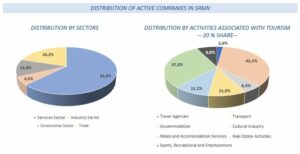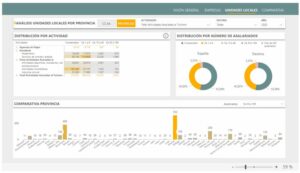20% of active Spanish companies are engaged in activities associated with tourism

A dashboard to consult the data of active companies and local units related to activities associated with tourism
- The Balearic Islands, the Canary Islands and the Principality of Asturias are the regions where tourism companies have the greatest representation.
- Dataestur shows tourism-focused information from the statistical usage of the Central Business Directory (DIRCE).
The latest data published by the INE on DIRCE statistics shows that 20% of Spanish companies are linked to activities associated with tourism, accounting for around 32% of companies in the Services sector. This is the main sector of the economy in Spain and makes up 6 out of every 10 active Spanish companies.
Practically half of the companies engaged in activities associated with tourism do not have employees, and around 47% have between 1 and 9 employees. These small companies are the most representative in the Hospitality industry (about 70%). In total, just over 2,500 companies (less than 0.5%) have more than 50 employees and more than half of these are companies linked to the hospitality industry. Additionally, 22% of hospitality businesses are less than two years old.

This is data that can be checked in the dashboard "Dataestur active companies in tourism", which offers a detailed view of companies and local units linked to tourism in autonomous regions and provinces. The categories included in the Tourism Satellite Account of Spain have been considered, i.e. hospitality, transportation, travel agencies and other activities associated with tourism (mainly related to creation, artistic and entertainment activities).
This data means that tourism contributed more than 9% of national employment and accounted for around 11.6% of Spain's GDP in 2022, according to data published by the INE last December in the Tourism Satellite Account of Spain.
Companies associated with tourist activities by autonomous region
Four autonomous regions stand out for the number of companies engaged in activities associated with tourism and bring together more than 60% of the total: Catalonia, which concentrates almost 20%; and Andalusia, the Region of Madrid and the Region of Valencia, which exceed 10% each.

If the largest companies are considered, the Canary Islands take centre stage and are only behind the Region of Madrid and Catalonia in terms of concentration of companies with 200 or more employees.

Nevertheless, the companies associated with tourism are mainly small and medium-sized enterprises. In fact, companies without employees are the majority in Catalonia, La Rioja, Aragon and the Region of Madrid. Small companies with between 1 and 9 employees exceed 50% of the total in the Basque Country, the Canary Islands, Cantabria and Galicia.
Regions where companies associated with tourism have the most presence
The Balearic and Canary Islands are the regions where companies associated with tourist activities have the most presence in the economy: they practically account for 1 in 4 of the total. They are followed by Andalusia, La Rioja and Cantabria, which also easily exceed 20% of the national average. On the opposite side, there are Castile-La Mancha and Navarre, where tourism companies account for only around 16%.

Is there a direct link between inbound tourism and the number of active tourism-related companies?
In order to answer this question, data from the INE's experimental statistics on measuring tourism through mobile telephony has been combined with data from the Central Business Directory. The number of tourists arriving in an autonomous region (international or interprovincial) has been linked to the number of active companies associated with tourist activities to make an approximate calculation of the number of existing companies in relation to the number of inbound tourists.

* Tourists in 2022 and the number of active companies as at 1 January 2023 have been taken into account.
The Principality of Asturias has the highest proportion of companies per number of tourists, one of the regions with the least tourism in 2022. Something similar occurs in the Region of Murcia, the third region with the highest ratio of companies associated with tourist activities and one of the regions with the least amount of tourists.
The autonomous regions with more tourists (Andalusia, Catalonia, Region of Valencia and Region of Madrid) are well above the national average as regards the presence of companies associated with tourist activities in relation to inbound tourists, except in the case of Andalusia (very close to average).
Information on activities associated with tourism and local units in each province
The Dataestur dashboard shows charts of the analysis of the number of employees for each tourism-related activity. Also, data can be compared between the autonomous regions and with the average in Spain.
Finally, it displays this information, but including data from the local units of each autonomous region and each province. It shows the distribution of establishments in each province and a more precise view of the business distribution associated with tourist activities. 
The dashboard offers historical data since 2008 and allows you to see the progress of companies active in the sector. However, due to the change in the definition of an active company after the entry into force of EBS Regulation 2019/2152, the 2023 data is not comparable to previous years.

